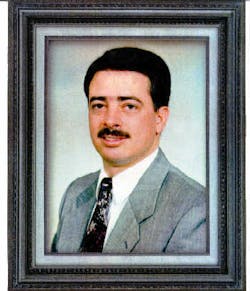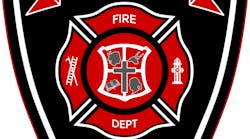Jimmy Heenan's fire gear was supposed to protect him.
Instead, the firefighter's family says, it failed him when he needed it most.
While crawling into a burning West Deptford house in 2001, Heenan fell through a collapsing kitchen floor and was trapped under debris in the
basement for at least 20 minutes. He died from burns three months later.
Since his death, new questions have been raised about the safety of his gear, as firefighters from seven other departments around the country have suffered strange burns.
Now a government agency is considering whether firefighters should be warned about a potential defect in the gear - known by the brand name Securitex and made with a material called Duralite - that could cause those injuries.
The manufacturer, a French company called Bacou-Dalloz, calls a potential government warning "defamatory" and argues that no gear could have protected Heenan from his injuries.
Heenan's wife, Patti, sued the company about a year after his death, based mostly on her instinct that something had to be wrong. The case is pending.
She said the extent of her husband's injuries had mystified other firefighters because there had been little fire damage to his gear and his clothes underneath had been unscathed.
"It didn't make sense," she said. "We were so shocked. How did he get so burned?"
About 90,000 sets of Duralite turnout gear have been sold in the last decade, court records say.
In August 2002, the International Association of Fire Fighters asked the federal government to study the gear after the union fielded burn complaints from departments in Springfield, Mass., and Harrisburg. That study, conducted at North Carolina State University's College of Textiles, found a critical flaw in the Duralite fabric used in the outer shell of the gear.
Under extreme heat, fibers in the Duralite break down, creating a "screen-door" effect that allows heat into the gear's interior layers, the study found.
The Heenan family's lawyers say that is what happened to him. When he fell through the floor, they argue, a flash fire burned off fibers in his coat, creating the screen-door effect. While Heenan was trapped, heat poured inside his coat, particularly through an area near the left shoulder, they said.
William Tambussi, one of the lawyers, said Heenan, a 37-year-old father of two, had been "steamed to death."
In a 10-page letter, Bacou-Dalloz ripped the North Carolina State report as "replete with inaccuracies" and "inherently flawed." The company also said the screen-door effect was not a sign of a "product deficiency" but "an important warning indicator... that the garment has undergone severe thermal loading and should be taken out of service."
An expert report written for the defense by Thomas E. Neal, an analytical chemist, concluded that Heenan's "turnout coat and bunker pants were still intact and effective," noting that the screenlike appearance on the left shoulder of the coat was tiny - about 2 to 3 percent of his total body area.
Neal attributed Heenan's death to his prolonged exposure to the heat in the basement. No "gear available could have protected Firefighter Heenan from the burn injuries he sustained," he said.
Bacou-Dalloz general counsel Winn Major said he could not comment on the case because of the lawsuit, but he added, "Clearly we feel strongly that our gear is a good product."
Westmont lawyer John Devlin, who is representing the company in the lawsuit, did not return three phone calls or respond to an e-mail request for comment.
In his court filings, Devlin noted that a report by the Gloucester County Fire Marshal's Office did not fault Heenan's gear, and that a casualty report by the chief and assistant chief of Heenan's volunteer Verga Fire Company found "no failure of the protective coat."
And a state investigation that cited eight factors in Heenan's death did not note any problems with his gear.
That report especially blamed the decision to spray "fog fire streams" into the basement. The streams "pushed the fire and superheated gases back down upon Heenan, thus causing the burn injuries that ultimately led to his death," the 2003 New Jersey report said. After those findings, Verga's chief and assistant chief were asked to resign.
But Tambussi pointed back to the North Carolina State report. In a letter last March, the National Personal Protective Technology Laboratory, under the U.S. Department of Health and Human Services, said it agreed with the university's findings and would prepare a notice to alert firefighters "about the potential material breakdown and inspection methods to identify the problem."
So far, the laboratory and its parent agency - the National Institute for Occupational Safety and Health - have taken no action on the study.
"We think NIOSH should have issued a warning already," Tambussi said.
And Patti Heenan said she, too, wanted the word to get out.
"The gear's still out there, and some people don't know there are problems with it," she said. "God forbid someone else has to go through what I went through."
In its letter, Bacou-Dalloz said the North Carolina State report "draws conclusions that are not supported by the data, uses inappropriate testing method, and provides no supporting data for many of its statements and suppositions."
The company urged NIOSH to "withdraw its intention to issue an advisory letter."
"We believe any such advisory is patently false, defamatory, and detrimental to the multitude of firefighters who employ these products on a daily basis," the letter said.
Fred Blosser, a NIOSH spokesman, said that a peer review of the study's methodology was being conducted, and that he did not know when any conclusions would be made.
"Bottom line, we want to be responsive to the concerns of firefighters," he said. "Theoretically, if there's a hazard out there and we've identified that hazard... we can put out recommended ways to control and prevent the problem."
Rich Duffy, the top safety official for the firefighters' union, said this month that he expected NIOSH to issue the report in its original form.
"If there's any changes in it, NIOSH is going to have to explain it," Duffy said. "I don't anticipate anything like that."
The union is prepared to issue its own warning to members about the Duralite gear as soon as the government makes the study's findings official. The union then would seek to upgrade the safety standards for protective gear.
The Duralite material meets the current standards for protecting firefighters.
The gear was designed to be lightweight and to dry quickly, with the idea that more firefighters die from heart attacks and other stress-related problems than from injuries while fighting fires.
Defense expert Neal also wrote that the burn injuries around the country needed to be viewed in the "context of the approximately 90,000 Duralite turnout systems that have been used by firefighters over the past 11 years."
"Firefighters have been burned wearing structural turnout gear made of virtually every type of protective material available," he added.
Tambussi argues that manufacturers knew - or should have known - about the screen-door effect and should have warned firefighters.
"The manufacturer is the party with the superior knowledge, and they have the duty to impart that knowledge," he said. "No gear is perfect, obviously, but you've got to give the firefighter a fighting chance."
For Patti Heenan, the revelations in the lawsuit have reaffirmed her faith in her instincts.
"I just want to get some closure," she said. "We lost my husband and the kids lost their dad, and to think about what's come out since then... it's crazy."
Life Lived Around the FirehouseThe Heenan family's life revolved around the Verga Fire Company in West Deptford.
Jimmy Heenan had been a volunteer since he was a teenager. He met his wife there, and she became a volunteer, as well.
The couple married in 1984 and raised two sons, now 18 and 20. Jimmy Heenan loved the fire service so much that he wanted to start a business cleaning and servicing fire gear.
The night of his death, both were attending a New Year's Eve party at the fire company. The call for the house fire on Atkins Avenue came in about 2:15 a.m. Jan. 1, 2001.
"The last thing he said was, 'Sit right there in that chair, and I'll be right back,' " Patti Heenan said.
She was still sitting in the firehouse when she heard the call on the scanner for "firefighter down."
"I could tell by the voice that something wasn't right," she said.
Another firefighter's wife, who lived next door to the firehouse, also heard the dispatch on a scanner. She called Heenan and offered to give her a ride to the fire.
By the time they arrived, Jimmy Heenan, 37, had been taken to Cooper University Hospital in Camden. He later was flown to Crozer-Chester Medical Center in Delaware County, where he died on March 25, 2001.
Patti Heenan continues to volunteer at the fire company, and she has a locker next to her husband's, which has been preserved.
She is taking classes and studying toward becoming a fire investigator.
"It's just something in my blood," she said. "I feel like he's watching over me."
Related






